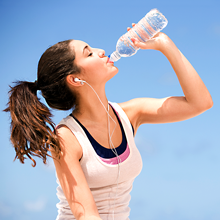July and August can be some of the hottest months in South Dakota. Along with a drastic change in temperature, many individuals participate in a variety of different sports and spend prolonged periods of time in the sun during this seasonal change. The human body serves as a great temperature regulator, but without practicing proper safety precautions, it is possible for the body to overheat.
Exercising in the heat increases your sweat rate, fluid loss, and your risk for dehydration. Sweating is how your thermoregulatory system within your body cools you down. If you become too hot, it is hard for your sweating rate to keep up and keep body temperatures down. Thus, with the increased temperatures outdoors, there is an increased risk for heat illnesses. Additionally, children are less efficient at regulating their body temperatures and can become overheated and dehydrated much quicker than an adult. If you as an adult feel hot, your child probably feels a lot warmer.
Common Heat Illnesses
Common heat illnesses include heat cramps, heat syncope, heat exhaustion, and heat stroke. Below are some common signs and symptoms for heat illnesses:
- Heat Cramps: Muscle twitching, cramps, spasms
- Heat Syncope: Pale skin, slowed heart rate, slowed breathing rate, nausea, weakness
- Heat Exhaustion: Excessive thirst, dry tongue/mouth, fatigue, weakness, nausea, slightly elevated temp, mental dullness, excessive sweating
- Heat Stroke: Central nervous system abnormalities (i.e. fatigue, confusion, headache, possible loss of consciousness, etc.), decreased or lack of sweating, rapidly increased heart rate and blood pressure
Safety Considerations
When engaging in physical activity during hot summer days or if you are going to be in the sun for prolonged hours follow these safety precautions:
- Wear loose-fitting, breathable, light-colored clothing
- Monitor hydration/fluid intake:
- Drink plenty of water – even if you don’t feel thirsty!
- Take frequent water breaks, especially during intense physical activity
- Avoid caffeinated drinks, such as pop or soda
- Drinks containing carbohydrates and electrolytes can also be consumed
- Find shelter in shaded areas
- Watch for signs and symptoms of heat illnesses (above)
- Avoid physical activity during peak heat, instead try early morning or late evening times
- Wear sunscreen
- Rest often and take it easy
Be mindful and pay attention to your body, if you suspect a heat illness seek medical help immediately. Dizziness, cramps, nausea, vomiting, confusion and headaches are all causes for alarm. If you need to, move your workout indoors for a few days.
Additional Resources
See more at SDSU Extension

